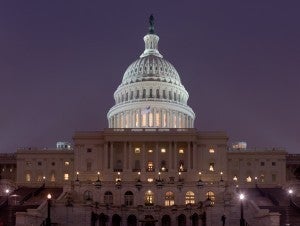
Minneapolis — one of 14 cities and counties that just announced legal support for the Clean Power Plan. Source Flickr/m01229.
The National League of Cities, the U.S. Conference of Mayors, and the cities of Baltimore (MD), Coral Gables (FL), Grand Rapids (MI), Houston (TX), Jersey City (NJ), Los Angeles (CA), Minneapolis (MN), Portland (OR), Pinecrest (FL), Providence (RI), Salt Lake City (UT), San Francisco (CA), West Palm Beach (FL) and Boulder County (CO) all filed a motion with the U.S. Court of Appeals for the D.C. Circuit to help defend the Clean Power Plan as amici curiae — or “friends of the court.” (The news was announced by the Sabin Center for Climate Change Law at Columbia University Law School – you can read their press release here.)
According to the motion filed by the cities:
The Local Government Coalition and its member national associations and local governments seek to participate as amici curiae to support their common view that the Clean Power Plan is a valid exercise of EPA’s authority and represents a reasonable interpretation of the ‘best system of emissions reduction’ standard established under Section 111(d) of the Clean Air Act. (Page 8)
That impressive group of cities joins a tremendously broad group of entities that are standing up for the Clean Power Plan. Some of these groups, including EDF, are parties to the case; others have filed as friends of the court or have filed supportive declarations:
- 18 states and seven other cities – including New York, Chicago, and Philadelphia – already filed with the court in support of these vital clean air safeguards.
- Power Companies – including Calpine, NextEra, National Grid Generation and many others– are supporting the Clean Power Plan, and the cities of Austin (TX) and Seattle (WA) are joining in that support through their municipal power departments.
- Public health groups like the American Lung Association, the Institute for Policy Integrity at New York University Law School, two former EPA Administrators who served under Republican Presidents Nixon, Reagan and George H.W. Bush, and environmental advocates – including EDF – are showing their support as well.
- A host of clean energy companies represented by Advanced Energy Economy and the national wind and solar associations weighed in on behalf of America’s $200 billion clean energy industry.
- Google, a major power consumer, filed a declaration in support for the Clean Power Plan, highlighting that it reinforces the company’s conclusion that purchasing renewable energy makes “good business sense” because of its “low and stable marginal cost.”
- More than six dozen experts have filed declarations with the court in support of the Clean Power Plan, including: former Secretary of State Madeleine Albright; Larry Soward, who led environmental policy under Texas Governor Rick Perry; Sue Tierney of Analysis Group, a leading energy and environmental expert; former FERC Chairmen from both sides of the aisle, including Joseph Kelliher who served under President George W. Bush; and the Rev. Sally Bingham of Interfaith Power & Light, and many others. (The declarations in support of the Clean Power Plan can be found here.)
- The National Nurses Union, our country’s largest professional association of registered nurses, highlighted the real world impacts of climate change and air pollution on community health, from asthma attacks to natural disasters
- Ron Busby, head of the U.S. Black Chambers, underscored the economic opportunities and electricity bill savings that American communities can realize under the Clean Power Plan.
It’s no surprise that the Clean Power Plan is winning such support. The U.S. Environmental Protection Agency (EPA) effort is the single biggest step America has ever taken to address the threat of climate change. It builds on our nation’s tremendous success in addressing soot and smog pollution from existing power plants, as well as our recent breakthrough progress in cutting greenhouse gas emissions from cars and trucks.
EPA estimates that by 2030, the Clean Power Plan will:
- Reduce carbon pollution from existing power plants 32 percent below 2005 levels
- Save 3,600 lives annually
- Prevent 90,000 childhood asthma attacks annually
- Save American families almost $85 on their annual energy bill
The Clean Power Plan will accomplish all this while building on the economic growth and job creation we’re already experiencing from the ongoing expansion of cost-effective clean energy nationwide.
The Clean Power Plan also gives states extensive flexibility to forge pollution-reduction strategies tailored to their individual needs and economic opportunities.
Opponents of the Clean Power Plan, including major emitters of harmful carbon pollution, started suing to stop it before EPA even finished writing it. (Various courts threw out those lawsuits). Their litigation — brought before they had even reviewed the final standards on the merits — illuminated objections that are highly reflexive.
The many and diverse supporters of the Clean Power Plan recognize that climate change is a threat to all of us, and that we must take action to address that threat. Allowing power plants to discharge unlimited amounts of carbon pollution into our air is a clear and present danger to public health, the environment and our economy, and we cannot allow it to continue. EDF is proud to be part of this vibrant group of supporters.
(Read more about the Clean Power Plan, and find all the legal briefs in the case, on our website.)










